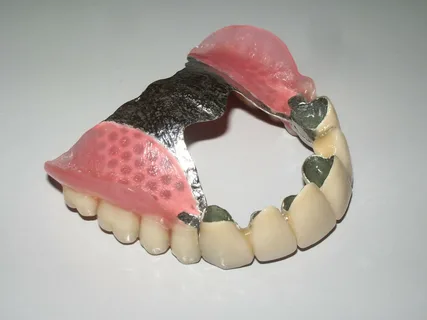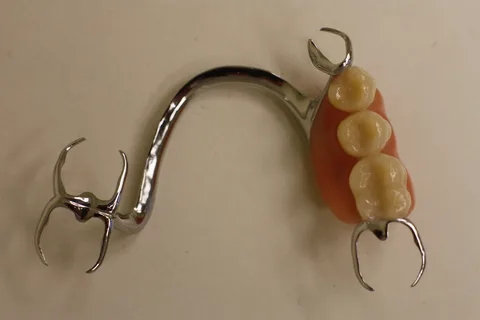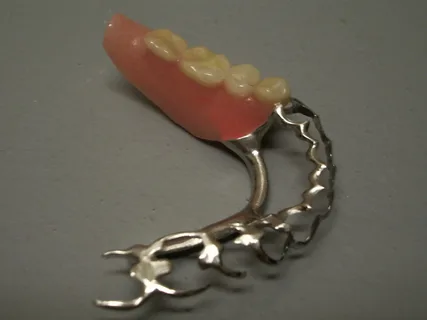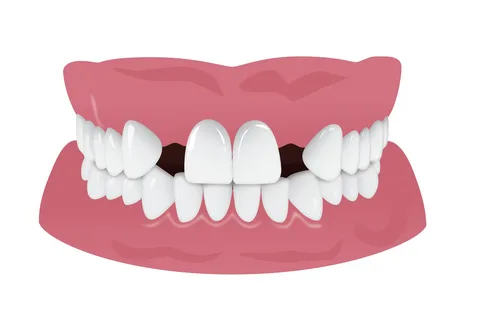Structural elements of a clasp prosthesis
Machine translation
Original article is written in RU language (link to read it).
Partial secondary adentia is a symptom complex that forms in the human dental system; its key pathological feature is the loss due to various reasons of the integrity of the dentition.
Treatment of this disease involves combining the patient’s remaining teeth through prosthetics of various designs into a single whole, as well as restoring the natural functioning of all components of the dental system.
Learn more about this topic in our online course Removable prosthetics without errors: a course for the “orthopedist-dental technician” team .

Rice. 1. Clasp denture for the lower jaw.
To achieve this goal, various orthopedic structures can be used:
bridges,
removable plate dentures,
clasp dentures.
Indications for the use of clasp dentures:
Unilateral end defect.
Bilateral end defect.
Included defect in the lateral section, provided that it extends from three teeth.
Included defect in the frontal region, extending from four teeth.
Defect in the integrity of the dentition against the background of periodontal tissue diseases.
Multiple violations of the integrity of the dentition.
In addition to the above indications, in order for the choice to fall on a clasp denture, along with the localization of the dentition defect, it is important to take into account some more points:
number of missing teeth,
anatomical characteristics of abutment teeth,
individual characteristics of the patient,
condition of the teeth of the opposite jaw,
presence of malocclusion.

Rice. 2. Saddle design.
Positive qualities of clasp dentures
The chewing load is distributed evenly onto the periodontium of the teeth, acting as a support, and also onto the mucous membrane of the prosthetic bed.
High functional efficiency.
The functional load is redistributed through clasps and other devices.
Clasp dentures, due to the peculiarities of their design, can act as a splint, redistributing and minimizing the functional overload of the remaining teeth.
Thanks to their stable fixation, clasp dentures reduce the horizontal load on the alveolar processes and supporting teeth.
Wearing these prostheses is accompanied by minimal distortion of tactile, taste and temperature sensitivity in the oral cavity.
Key elements of the clasp prosthesis design
The base, or saddle, is a part of the prosthesis design, which involves the placement of artificial teeth on it, restoring the lost area of the alveolar process.
Retention devices are elements that are necessary to hold the prosthesis on the supporting teeth during the functions of chewing and speech.
Connecting elements are used to combine all structural parts of the prosthesis into a single whole: saddles and retention devices.
Indirect fasteners.

Rice. 3. Clasp denture for unilateral dentition defect.
Prosthesis base
The saddle, or base, is a component of a supported prosthesis, which includes artificial teeth, as well as a replaced portion of the alveolar process.
The base can be made of the following materials:
plastic,
metal,
or be a combination.
Requirements for base material
maintain constant dimensions and shape during processing, wearing and repairing if necessary;
be indifferent to the tissues of the oral cavity;
have high strength characteristics with low thickness;
do not swell during operation;
have high aesthetic characteristics and color fastness during operation;
have a high level of elasticity;
simple repair or relining in case of atrophy of surrounding tissues;
the material should be easy to polish and maintain a smooth polished surface for a long period of time;
good wear resistance during daily use;
insignificant specific gravity;
good thermal conductivity.
Despite the constant improvement and introduction of new modern materials, none of them is able to satisfy all of the above requirements. In this regard, experts prefer to use combined bases.
The connection between the base and the plastic is carried out using a loop or ladder frame. In this case, the frame should be located 1 mm from the surface of the mucous membrane of the prosthetic bed on the oral slope of the alveolar process. It is important that the alveolar ridge is covered with plastic. The posterior border of the frame cannot protrude beyond the area of the tuberosities. The thickness of the metal frame elements - hinges or crossbars - cannot be more than 1–1.5 mm.

Rice. 4. Clasp denture with a multi-link clasp for splinting mobile teeth.
The connection of artificial teeth in clasp dentures is determined by the type of material used.
Plastic teeth are connected to the plastic base monolithically thanks to chemical bonds, and to the metal base - mechanically due to various retention elements (brackets or loops).
Crampon and diator teeth made of porcelain are fixed mechanically using plastic.
Tubular teeth are connected using cement; they are mounted on metal vertical processes, which are cast together with the prosthetic frame.
It has been clinically proven that if a patient has mucosal pathology, it is recommended to use a well-polished metal base in the design of the supported prosthesis. Since its thermal conductivity indicators provide the damaged mucosa with a therapeutic effect. It is also believed that under a metal base, bone resorption is slowed down.
Frequent mistakes and complications when planning a base structure
The desire to reduce the area of a freely ending base causes, during its active use, excessive trauma to the mucous membrane, and sometimes rapidly progressive resorption of the underlying bone, as a result of which the base sinks. The latter entails overloading of the supporting teeth, the appearance of their mobility, the result is the formation of a vicious circle, where the desire to reduce the structure of the base leads to the loss of teeth.
The uneven distance between the mucous membrane of the prosthetic bed and the base of the prosthesis causes accelerated atrophy of bone tissue.
It is recommended to plan the base area so that it is three times larger than the area occupied by artificial lateral teeth. Otherwise, during the operation of the prosthesis, excessive load occurs, aggravating bone resorption. It is advisable to try to increase the base in the lower jaw, extending it into the retromolar region, and in the upper jaw to overlap the tubercle.
Optimal boundaries of the base of a supported prosthesis
On the lower jaw, the posterior border should be located behind the mandibular tubercles; on the upper jaw, it should overlap the maxillary tubercles.
The anterior border on both jaws is located in the neutral zone, bypassing the buccal cords and folds.
From the side of the oral cavity, the border of the base on the upper jaw can be localized in different ways:
in the case of a well-defined alveolar process, the border corresponds to the transition of the alveolar process into the palate;
If the patient has a flat palate and the alveolar process is poorly defined, it is necessary to partially block the hard palate and replace the arch with a palatal plate.

Rice. 5. Clasp denture for the lower jaw.
The border of the base on the lower jaw from the side of the oral cavity is determined by the severity of the alveolar process and the characteristics of muscle attachment.
In the sublingual region, the border is located 2 mm before the transition of the alveolar process into the mucous membrane of the floor of the oral cavity.
In the retroalveolar - without sharp transitions it connects with the distal border or ends in the “wing of the base”.
Types of connection between the prosthesis frame and the base:
hard;
springy;
articulated.
The type of fixation of clasps with saddles depends on several factors:
stability and number of supporting teeth;
topography and extent of the defect;
pliability of the mucosa;
functional relationship of the dentition.
If the teeth acting as supporting teeth on the opposite jaw are opposed by a removable denture, in this case a rigid articulation of the clasps is preferable, it will not have a negative effect on the supporting tissues.
But when the opposite jaw has an intact row of teeth, the maximum load should be transferred to the mucous membrane, which is ensured by a springy connection.
The use of labile and semi-labile connections is technically more complex compared to a rigid connection, which, with rational placement of supporting devices, reduces the negative impact of the prosthesis on surrounding tissues. But in some clinical cases it is impossible to do without using a spring or hinged connection in the design.
Learn more about errors in removable prosthetics at the webinar Errors in diagnosis and treatment planning .





